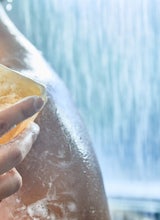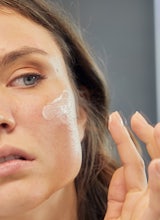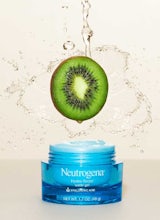Your earliest experience with zinc oxide sunscreens might have been with a thick, gloppy lotion that made you look like a melting marshmallow.
But zinc oxide sunscreens have come a long way in recent decades. The principal scientist for Neutrogena® in the Sun Care Product and Process Development division, Julie Bianchini, Ph.D., has made it her business to help break those stereotypes.
Here's how Neutrogena® innovates on that old zinc oxide formula.
What Is Zinc Oxide Sunscreen?
Chances are, zinc oxide has already made its way into your personal care routine, even if you weren't totally aware of it. This naturally derived mineral ingredient is a star player in some products you might not expect — such as being the active ingredient in diaper rash creams and ointments — as well as the ones you're familiar with — namely sunscreens. "Zinc oxide can also be used in cosmetic makeups to increase the opacity and the coverage of the product, or it can be found in other Over The Counter (OTC) products as an active ingredient that protects and treats minor skin irritations," says Dr. Bianchini.
Zinc oxide and titanium dioxide are the two mineral sunscreen filters generally recognized as safe and effective by the FDA. These two sunscreen active ingredients form a barrier on the surface of the skin to protect from the sun’s damaging ultraviolet (UV) rays. As shown in a publication in the Journal of the American Academy of Dermatology, zinc oxide provides broad-spectrum protection against both UVB and UVA rays (as a quick refresher, UVB rays are associated with sunburns, while UVA rays cause skin aging, and both contribute to skin cancer). In 2015, Neutrogena® was one of the first brands to publish a study showing how zinc oxide works as a sunscreen filter. Rather than allowing sunlight to hit skin directly, zinc oxide works to reflect, scatter and absorb both the UVB and UVA rays.
How Neutrogena® Formulates Zinc Oxide Sunscreens
Neutrogena® has been formulating mineral sunscreens for over 25 years and was one of the first companies to include a zinc oxide concentration of higher than 20% in its mineral sunscreen lotion. It takes 9 months to a year for Neutrogena® to formulate a new sunscreen. Here's a peek into that process.
Zinc oxide is an inorganic sunscreen filter, "which means that the actual zinc oxide molecule does not contain carbon," explains Dr. Bianchini. A chemical sunscreen filter that is labeled "organic" means that it contains carbon atoms —not that it’s any more likely to be found at your local farmer’s market. "When we talk about organic versus inorganic sun filters, we're talking about them from the chemical definition of the sun filter."
Neutrogena® sunscreen lotions that contain zinc oxide are emulsions — a mixture of two liquid phases, usually oil and water. Usually, when oil and water are mixed, they don’t like to stay together. However, including ingredients like emulsifiers, which have both water-loving (hydrophilic) and oil-loving (hydrophobic) properties, hold the two phases of the emulsion together. The zinc oxide is dispersed within the oil phase, and then both the oil phase and the water phase are homogenized to form the final emulsion, or sunscreen lotion. Neutrogena® sunscreen sticks are anhydrous, which means there's no water in the formula. The zinc oxide is dispersed in oils, and waxes are added to give the formula its solid structure.
Before a new formula enters the market, it undergoes rigorous testing — after all, it can't run into your eyes, sting or clog pores. And at Neutrogena®, when formulas are being developed they are tested under stress conditions such as high heat and freeze/thaw cycles to ensure they are stable under these extreme conditions "All of our recreational sunscreens provide water resistance, which is tested through an FDA test method where the subjects are immersed in water for 40 or 80 minutes and then the SPF value is determined. This ensures that sunscreen is efficacious for using in a recreational setting while swimming or sweating" says Dr. Bianchini.
Neutrogena® may test hundreds of prototype formulas in the lab before landing on the perfect one for final development.
How Neutrogena® Innovates New Zinc Oxide Sunscreens
Traditional zinc oxide sunscreens can have an unpleasant smell, texture, or appearance, but when designing new zinc oxide sunscreens to improve these pain points, Neutrogena® ensures that the mineral sunscreens feel great on your skin, are easy to apply, and do not compromise on protection. Neutrogena® formulates zinc oxide sunscreens with a high percentage of evenly dispersed zinc oxide particles that when rubbed into the skin provides a non-greasy, sheer finish.
This also comes with good news about the all-too-visible white cast. "There's been a lot of innovation in the category that has focused on the zinc oxide particle itself, the way that the zinc oxide is dispersed within the formula, and how we generate the final sunscreen product that has enhances the aesthetics — like improving the non-whitening aspect, which makes the experience of using these zinc oxide lotion and stick products very pleasant," says Dr. Bianchini.
It's true, you'll still see the sunscreen on your skin before it's rubbed in. But that can be an advantage: "Because of the primary particle size of the zinc oxide itself, it's always going to have an opacity," says Dr. Bianchini. As you apply, you'll be able to tell if you missed any spots. Then, once you know you're covered, you can blend it into invisibility.
For example, when you apply Neutrogena Sheer Zinc® Mineral Sunscreen Stick you'll be able to see it where it goes, and then after rubbing in, it dries with a clear finish, leaves no white residue, and is invisible on skin. Furthermore, the Neutrogena Sheer Zinc® Mineral Sunscreen Stick has been shown to be 3.7x less whitening than a leading competitor on darker skin tones.
Which Zinc Oxide Sunscreen Is Right for You?
Always go for a sunscreen with SPF 30 or above with broad spectrum UVB/UVA protection— but beyond that, you have plenty of options for different skin types and activities. Neutrogena® offers mineral sunscreen lotions and sticks, sunscreens for sensitive skin, sunscreens for kids and sunscreens for acne-prone skin, just to name a few.
"It's a good idea to have a variety of products in your arsenal, like a stick where you can easily touch up spots when you're on the go and then lotions for when you need all-over coverage for a day in the sun," says Dr. Bianchini.
Whatever your skin concern, there's a sunscreen gentle enough for it. After all, what is zinc oxide best known for? Being the perfect option for people with sensitive skin, as zinc oxide has a low risk of skin sensitization or irritation. Neutrogena® Sensitive Skin lotion, which contains both zinc oxide and titanium dioxide, goes the full mile and avoids any potential inertance that may be caused by fragrance, dyes and oils, so it's gentle enough for sensitive skin, including those with eczema. Neutrogena Sheer Zinc® Dry Touch sunscreen is noncomedogenic, meaning it won't clog pores, and has been clinically proven to be mild even on sensitive skin. The creamy texture dries to a lightweight, non-greasy finish.
How to Use Zinc Oxide Sunscreens
Apply Neutrogena® broad spectrum sunscreen 15 minutes before sun exposure, especially if you plan to sweat or take a dip. "You want to allow enough time to dry so the product forms a film properly on your skin to avoid being washed off and to effectively protect your skin from UV rays," Dr. Bianchini says. Also, always check the expiration date on the bottle or on the tube so you know that you're using the product within its expiration date."











